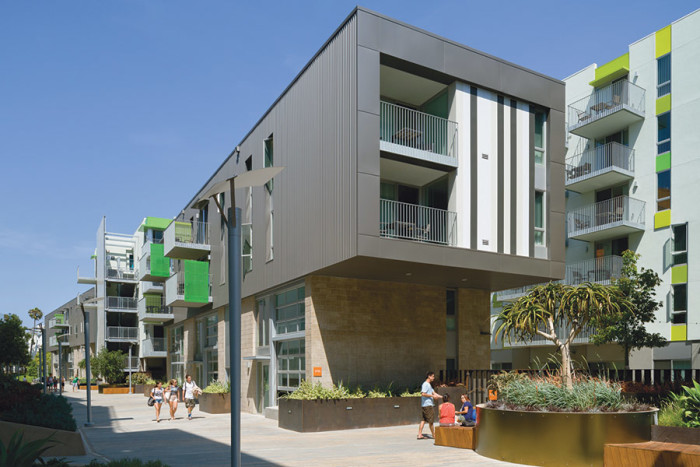
The conservative no-growth group, Residocracy, has begun gathering signatures to put an initiative on the November ballot that would require nearly all new projects taller than 32 feet to be approved by a popular vote.
The group, whose opposition to the Bergamot Transit Village project in 2014 brought us the suburban office park we will soon be getting at that site, launched its signature-gathering campaign this weekend with a party at Robert Berman Gallery in Santa Monica’s Bergamot Station. However, even one-time allies of the group are concerned that the so-called “LUVE” (Land Use Voter Empowerment) initiative, with its extremely low thresholds and minimal exceptions, goes too far. The full text of the initiative is available here.
“Eight years ago I supported a voter initiative to control commercial growth, which is still a concern. While that previous measure would have established an annual cap, allowing Santa Monica to pick only the best projects, what is currently proposed dissuades all kinds of moderate-sized projects, including housing,” said Santa Monica City Councilmember Kevin McKeown in an email yesterday. McKeown was referring to his support for Prop T — also known as RIFT (Residents’ Initiative to Fight Traffic) — which was put to voters in 2008.
Had it passed, Prop T would have capped commercial development at 75,000 square feet a year, but it was decisively defeated when more than 56 percent of voters rejected it.
“[Residocracy’s initiative] also appears to give developers the ability to initiate special elections, where they can pour unlimited corporate financing into local low-turnout balloting. We need housing, and we don’t need more developer influence on our politics,” McKeown said.
The initiative requires that almost all development proposals for buildings over 32 feet be put on the ballot, which, as McKeown notes, would result in expensive political campaigns over each individual project, a process that would be cost-prohibitive to all but only the wealthiest developers.
Councilmember Pam O’Connor, who often finds herself on the opposite side of the growth debate as McKeown, agrees. “It gives developers the power to call elections–it’s ballot-box planning at its worst,” she said in an email yesterday, adding that the initiative would trump years of work by the community and replace it with standards unvetted by any community process.
“The Land Use and Circulation Element (LUCE) was the result of a multi-year community process; this ballot initiative was put together without any public input or process,” she said, referring to the current document that guides the city’s planning.
Councilmember Terry O’Day said the initiative would likely have a lot of negative consequences. “The implications of this initiative are profound and its proponents are misguided,” he said. “The initiative would increase the cost of housing and services, increase city red tape and costs, thwart neighborhood improvements and impede environmental sustainability efforts.”
Councilmember Ted Winterer also had strong reservations about the severity of the measure, which would only exempt some affordable housing projects from the threshold requiring a popular vote.
“I appreciate and understand the sentiments behind the LUVE initiative, as there’s been a lot of change in Santa Monica in recent years which has been challenging for many of our residents,” Winterer said in an email yesterday.
“However, I believe the measure goes too far by requiring voter approval of projects over two stories. Market forces will gentrify and change forever places like the Pico neighborhood if we’re unable to provide new housing downtown within the height limits which have been in place for many years,” he said, referring to the Santa Monica neighborhood that has historically been home to many Latino and African-American residents.
Winterer and McKeown’s opposition to the initiative suggests that Residocracy has failed this time around to build the same coalition it had during its campaign against the Bergamot Transit Village project, since both councilmembers joined Residocracy in opposing that particular project.
Per Santa Monica’s election rules, Residocracy has 180 days to gather enough signatures to qualify the initiative for the ballot. With the threshold being relatively low — they will need to gather about 6,100 qualified signatures, or 10 percent of registered voters — it is very likely that the initiative will qualify for the ballot.
Once the initiative qualifies for the ballot, the Council will have the option of adopting the ordinance as-is or putting it before voters.
The so-called LUVE initiative is similar to actions taken by more conservative coastal cities like Encinitas. In June 2013, voters in Encinitas narrowly approved Proposition A, which put a blanket cap on height and density of new buildings. However, Encinitas soon came under fire for violating state law, which allows density bonuses in new housing construction when the projects include affordable housing.
In July, the city settled and agreed to allow the density bonuses mandated by state law, but the suit still ended up costing the city $200,000.
Residocracy is likely to pitch its initiative as a traffic relief measure, similar to Prop T in 2008. However, as noted by McKeown, one main difference is that Prop T targeted commercial growth exclusively. Santa Monica’s housing shortage is actually one of the main causes of the daily commuter traffic. Since the 1960 census, Santa Monica’s resident population has increased by less than 10,000 people. However, it is estimated that Santa Monica’s day time population doubles on account of the number of people who come to the city to work.
With minimal housing growth over the decades, workers have little choice but to live elsewhere and commute into the city for work. The morning and evening commuter jams are a direct testament to the fact that most people who work in Santa Monica can’t find places to live here.

